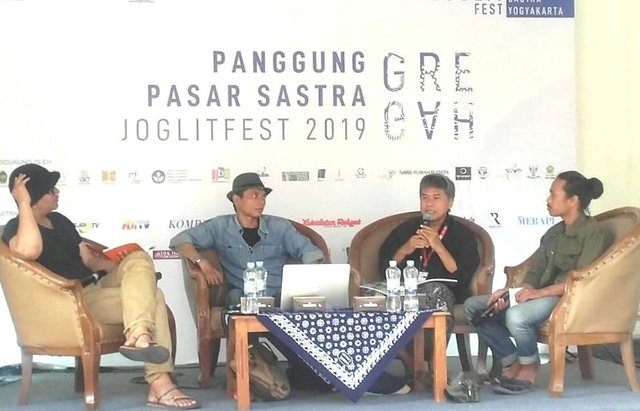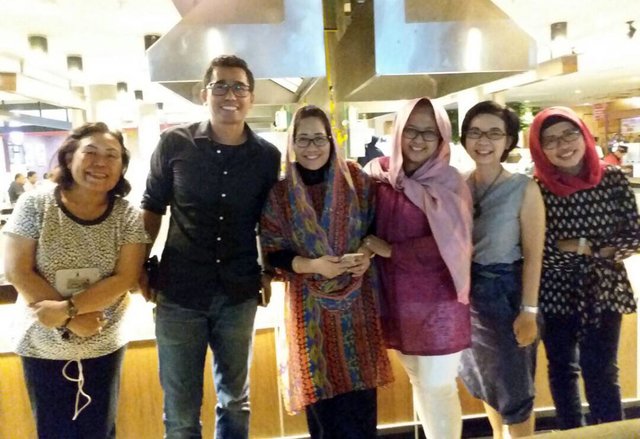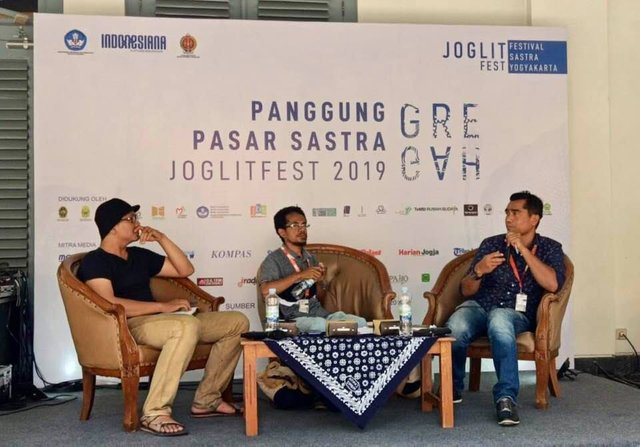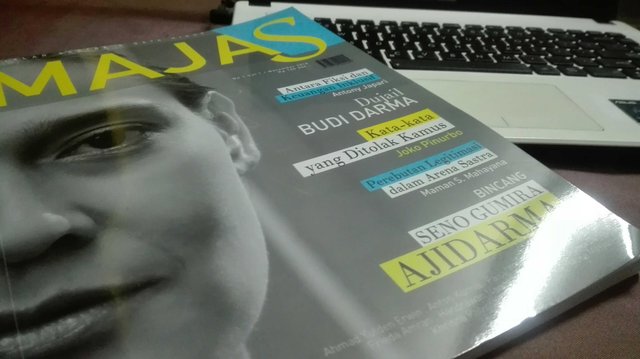Literary Magazine in the Digital Age | Majalah Sastra di Era Digital |

The title above adopted the post of Kurnia Effendi on Facebook when he was a speaker at the Yogyakarta International Literary Festival (Joglisfet) in Yogyakarta, 26-30 September 2019. Kurnia Effendi, who is familiarly called Keff, together with four of his colleagues gave birth to Majas, a literary and lifestyle magazine amidst many other magazines that are subject to digital technology distribution.
Many doubted magazines — especially literary magazines — would be able to survive amid the onslaught of online media technology. Buying magazines is considered to be a part of the past. Many magazines were left dead by readers, including lifestyle magazines which usually included fictional works such as short stories and serialized stories.
I belong to the generation of writers who built careers in magazines. My first work was published in "Aneka Yess" magazine, if I'm not mistaken in 1992 (I had the documentation but when I wrote this in the office, the documentation was at home). Aneka Yess is a teen magazine in Indonesia which has produced a lot of cover models that are now celebrities in Indonesia, in addition to many writers who have worked there. At first, the magazine was named Aneka Ria and later changed to Aneka Yess!.
But my most short stories were published in the magazine Anita Cemerlang, a teenage fiction magazine that gave birth to many writers. Kurnia Effendi gave birth to the Masajas with the writers of the Anita alumni; Kurniawan Junaedhie, Ana Mustaminl, and Agnes Majestika. Another one is Valent Mustamin, a professional in the field of information technology.
Kurnia Effendi was invited to present the literary and lifestyle magazine Majas at the 2019 Joglitfest event. She appeared on the stage at the Jogya Vredeburg Museum on September 29, 2019 at 14.00 WIB. On the same stage, one hour earlier I and a writer from Papua, Gody Usnaat, had just finished reviewing the book "Sowing the Demon Orchid" by Charles Dickens et al.
In the forum, Kurnia Effendi acknowledged there was a sharp clash between "passion celebrating romanticism" and the challenges of "digital technology" that ran fast carrying literacy material away from the era of physical print media.
The print media carries burdens such as (1) High costs ranging from production, distribution, to the payment of the honorarium of the authors; (2) Who are the readers of the print media at a time when the millennial wave is different and fanatical about the smartphone and the internet?
However, Kurnia Effendi claimed to be stunned by at least two realities that are still developing today.
- Social media, especially Facebook, on Saturdays and Sundays will be filled with photos of newspapers or magazines containing the work of writers (especially millennials). That is a kind of sign that even though they have a school of online readers, they feel proud when their works (poems, short stories, essays) are printed in physical print media so they need to show off. What ambiguity is happening in their souls? Senior writers may be used to being loaded like that, even bored showing it off.
- A millennial celebrity, Marchela Fp, who made an Instagram story with followers of thousands of people, apparently also needs to publish quotes and fiction into a book that can be held. In fact, orders before the publication date reaches the 11th print. Are the fans not enough to read through cellphones or e-books? Previous celebrities also passed the same thing: Raditya Dika, who later developed it was not limited to reading, but also film.
Kurnia Effendi also revealed the results of his discussions with several major publishers in Indonesia. The major publishers acknowledge the benefits of selling e-books are nothing compared to physical book sales.
The fact above does not necessarily guarantee Majas will be long-lived. In a personal conversation with me, it was realized by Kurnia Effendi et al. They also prepare marketing strategies that have the potential to bind readers and build a sense of ownership. Every reader who buys four editions at once, will get shares from Majas.
Uniquely, one person can only get one share even though the reader (read: investor) has a lot of money. With a system like this, there is no majority owner of shares in Majas.
Aside from circulation, to guarantee production costs, in my opinion Majas must also get advertisements, especially cultural advertisements which are increasingly being held in Indonesia lately. Commercial advertisers certainly consider circulation and the number of readers and other aspects when deciding to advertise. However, advertising from cultural institutions is not 100 percent using business considerations.
So far, Majas has gotten advertisements for several editions. Reportedly until early 2020, Majas has already gotten advertising contracts with several leading banks in Indonesia.
In addition, because of the large amount of educational content in Majas content, this magazine should be in libraries in high schools and universities throughout Indonesia. With this strategy, Majas will continue to be present with quality literary works.[]

Saya bersama penulis Anita, termasuk pendiri Majas, Ana Mustamin, dalam sebuah acara di Jakarta.
Majalah Sastra Dalam Era Digital
Judul di atas mengadopsi postingan Kurnia Effendi di Facebook ketika menjadi pemateri dalam Jogyakarta International Literary Festival (Joglisfet) di Jogyakarta, 26 – 30 September 2019 lalu. Kurnia Effendi yang akrab disapa Keff, bersama empat rekannya melahirkan Majas, majalah sastra dan gaya hidup di tengah banyak majalah lain berguguran distrupsi teknologi digital.
Banyak yang meragukan majalah—apalagi majalah sastra—akan bisa survive di tengah gempuran teknologi media online. Membeli majalah dianggap sudah menjadi bagian masa lalu. Banyak majalah tewas ditinggal pembaca, termasuk majalah gaya hidup yang biasanya juga memuat karya fiksi seperti cerpen dan cerita bersambung.
Saya termasuk generasi penulis yang membangun karier di majalah. Karya pertama saya dimuat di majalah Aneka Yess, kalau tak salah pada tahun 1992 (saya punya dokumentasinya tetapi ketika menulis ini di kantor, dokumentasinya ada di rumah). Aneka Yess adalah sebuah majalah remaja di Indonesia yang banyak melahirkan model sampul yang kini menjadi pesohor di Indonesia, selain banyak penulis yang berkarier di sana. Pada awalnya, majalah itu bernama Aneka Ria dan kemudian berubah menjadi Aneka Yess!.
Tapi cerpen terbanyak saya dimuat di majalah Anita Cemerlang, majalah fiksi remaja yang banyak melahirkan penulis. Kurnia Effendi melahirkan Majas bersama para penulis alumni Anita; Kurniawan Junaedhie, Ana Mustaminl, dan Agnes Majestika. Seorang lagi adalah Valent Mustamin, seorang tenaga profesional di bidang teknologi informatika.
Kurnia Effendi diudang untuk mempresentasikan majalah sastra dan gaya hidup Majas dalam acara Joglitfest 2019. Dia tampil di panggung di Museum Vredeburg Jogya pada 29 September 2019 pukul 14.00 WIB. Di panggung sama, satu jam sebelumnya saya dan penulis dari Papua, Gody Usnaat, baru saya menyelesaikan bedah buku “Menyemai Anggrek Setan” karya Charles Dickens dkk.
Dalam forum tersebut, Kurnia Effendi mengakui ada perbenturan tajam antara “passion merayakan romantisme” dan tantangan “teknologi digital” yang lari kencang membawa serta materi literasi meninggalkan zaman media cetak yang berwujud fisik.
Media cetak menanggung beban seperti (1) Berbiaya tinggi mulai dari produksi, distribusi, hingga pembayaran honorarium para penulis; (2) Siapa para pembaca media cetak di saat gelombang generasi milenial sudah berbeda cara dan fanatik terhadap smartphone dan internet?
Namun, Kurnia Effendi mengaku terperangah oleh minimal dua kenyataan yang masih berkembang saat ini.
- Media sosial, terutama facebook, pada hari Sabtu dan Minggu akan dipenuhi foto-foto koran atau majalah yang memuat karya para penulis (terutama generasi milenial). Itu semacam tanda bahwa sekalipun mereka memiliki mazhab pembaca online, ternyata merasa bangga ketika karyanya (puisi, cerpen, esai) dimuat media cetak fisikal sehingga perlu pamer. Ambiguitas apa gerangan yang sedang melanda jiwa mereka? Penulis senior mungkin sudah biasa dimuat seperti itu, malah bosan memamerkannya.
- Seorang pesohor milenial, Marchela Fp, yang membuat cerita instagram dengan pengikut ribuan orang, ternyata perlu juga menerbitkan quote-quote dan fiksinya menjadi buku yang bisa dipegang. Bahkan, pemesanan sebelum tanggal terbitnya mencapai cetakan ke-11. Apa para penggemarnya tidak cukup dengan membaca melalui HP atau e-book? Pesohor sebelumnya pun melewati hal yang sama: Raditya Dika, yang kemudian mengembangkannya tak sebatas bacaan, tetapi juga film.
Kurnia Effendi juga mengungkapkan hasil perbincangannya dengan beberapa penerbit major di Indonesia. Para penerbit major tersebut mengakui keuntungan penjualan e-book belum seberapa dibanding penjualan buku secara fisik.
Kenyataan di atas tidak serta merta akan menjamin Majas akan berumur panjang. Dalam perbincangan secara personal dengan saya, hal itu disadari oleh Kurnia Effendi dkk. Mereka pun menyiapkan strategi marketing yang berpotensi mengikat pembaca dan membangun rasa kepemilikan. Setiap pembaca yang membeli empat edisi sekaligus, akan mendapatkan saham dari Majas.
Uniknya, satu orang hanya bisa mendapatkan satu lembar saham meski sang pembaca (baca: investor) memiliki banyak uang. Dengan sistem seperti ini, tidak ada pemilik mayoritas saham di Majas.
Selain dari oplah, untuk menjamin biaya produksi,menurut saya Majas juga harus mendapatkan iklan, terutama iklan budaya yang belakangan semakin banyak digelar di Indonesia. Pemasang iklan dari komersial tentu mempertibangkan oplah dan jumlah pembaca dan aspek lain ketika memutuskan untuk memasang iklan. Namun, iklan dari lembaga kebudayaan tidak 100 persen menggunakan pertimbangan bisnis.
Sejauh ini, Majas sudah mendapatkan iklan untuk beberapa edisi. Kabarnya sampai awal 2020 mendatang, Majas sudah mendapatkan kontrak iklan dengan beberapa bank terkemuka di Indonesia.
Selain itu, karena muatan pendidikan banyak dalam konten Majas, majalah ini harusnya berada di perpustakaan di SMA dan perguruan tinggi di seluruh Indonesia. Dengan strategi demikian, Majas akan terus hadir dengan karya sastra berkualitas.[]




To listen to the audio version of this article click on the play image.

Brought to you by @tts. If you find it useful please consider upvoting this reply.
It is very important to keep reading literary magazine in digital age.
Thanks for your contribution.
Regards,
@anggreklestari
[Realityhubs Curator]
Hello, @ayijufridar! You just received a vote from realityhubs curation account. Thanks for publishing your awesome review with the RealityHubs tag. Use the RealityHubs interface www.realityhubs.com to publish your reviews and receive greater rewards.
You can also delegate to our curation account (@reality.curate) to get a daily RHB reward. For more information, click here.
Do you want to get 400,000 RHB delegated to you to reward fellow awesome reviewers on the platform? Click here to learn how to apply for a delegation.
We love to see great reviews like yours and we look forward to seeing more awesome reviews from you.
Cheers!